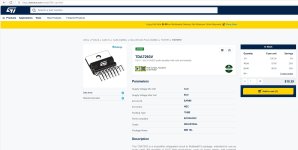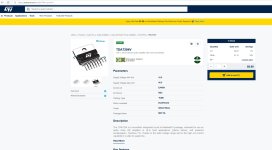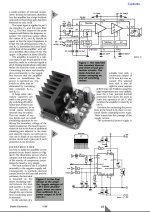Remember that TDA7294/7293 yet are power opamps, i. e. feature an inverting and a non inverting input. For BTL, you may design a pair of those accordingly. Or you provide two additional opamps, one in non inverting, the other one in inverting mode, to drive the chips.Hi, tnvijay
Just found this thread as i was attempting to make an amp circuit using the tda7294. Im curious, if i can use MadF1 by Lincor design to make a bridge amp to drive high powered speakers.
Best regards!
I've built this designer's particular 7294 based amp as well as his mosfet amp. It sounds perfectly fine but I've yet to find any 7293/94 based amps that made me jump from my my LM3886-based My-Ref EVO boards. He was very pleasant to deal with.Can't go through the entire thread. But I thought I should share this .Moderators kindly remove the post of the schema is already discussed. There are a couple of Russian designers who has done extensive work on tda 7294 series chips. Unfortunately,they are all in Russian and a regular Google search like tda 7294 doess not yield those pages..
1.Search for TDA 7294 LINCOR MF1 .The Russian pages can be translated and read in English. The schema is a mixed voltage and current feedback ,and uses a F shaped feedback loop. The. Author ,whose pen name is LINCOR, gives explanation and explains how he tried to achieve near flat response across frequently spectrum without resonance peak boom. There is a printable PDF layout and the construction is very easy ,even for novice.Now, most importantly,how does it sound..? Having used this amplifier for about one year, I can vouch for its sonic quality. Subjectively, the music is very fluid and easy to listen. No listener fatigue , A special word on the deep, yet controlled bass. One has to build and listen to believe... Considering the cost and simplicity to build,this could make one fine amplifier...
2. Search for tda 7294 audiokiller. Another Russian, with the pen name audio killer,has an entire page dedicated to tda 7294 . He also proposes mixed feedback topology and gives software for calculating feedback resistor for tweaking.. Really a different dimension for these chip amps..I will try to copy the link tomorrow.
https://electroclub.info/en/developments/hi-fi-amplifier-on-tda7294-tda7293-chip/
Cheers
As I can see there is steel interest for this chip (TDA7294). I just buy a couple ICs for 13 Euros ppc. Not a cheap one for a so "sensitive" IC. The pcb I have "available" is from an article of ELEKTOR magazine (November 1996) and I'm trying to figure out how to modify it without destruct completely the pcb nor the IC due to supply the input part with 38,5V and the output with 30,5 ~ 31V (yes I have the schema of that p.s. in page 6 I think of this tread)
Elias
Elias
They are the same family, use Google or their competitors for specs.
Output watts and supply volts are different.
Only one is still in production.
Output watts and supply volts are different.
Only one is still in production.
"Only one is still in production."
That is not accurate, as we speak, both of the tda7293 and 7294 are very much active and available to purchase at most of the trusted distributors including direct purchase from ST.com .
The only discontinued TDA7293 is the TDA7293Hs.
That is not accurate, as we speak, both of the tda7293 and 7294 are very much active and available to purchase at most of the trusted distributors including direct purchase from ST.com .
The only discontinued TDA7293 is the TDA7293Hs.
Attachments
TDA7293 is superior in distinctive aspects (higher supply voltage ratings, higher max. output power, possibility of paralleling the power sections of two or even more devices, see pin 11). I'd prefer it (and forget about 7294...).is tda7294 any better than tda7293?
Best regards!
Is it better to just use audio killers design for 2 mono amps powering 2 high quality speakers and use a standard bridge 7294 configuration from the datasheet for a subwoofer. Maybe just change the input and bootstrap cap for better lower bass.
Yes, Mouser has them both in India, single units in the $10 price range, when I checked on the ST site last year one was not even listed.
Bear in mind they check your location and tell you what is available for you.
The 7294 likes to go bang, just like the old STK modules it seems.
Better to put a ready plate amplifier for a new build, and for repair, well your decision..
Bear in mind they check your location and tell you what is available for you.
The 7294 likes to go bang, just like the old STK modules it seems.
Better to put a ready plate amplifier for a new build, and for repair, well your decision..
Like with any power amp IC, if you derate them properly (to 75% max supply etc) and have the recommended mute/standby sequencing and also have catch diodes on the output then, IME, TDA7293/94 "live forever" and can take abuse, provided that the heatsinking is also up to the task. There is no way you can reliably push them above 50...60Watts continuous dissipation (see datasheets, Absolute maximum ratings, the line "Total power dissipation (Tcase = 70°C) : 50 W").The 7294 likes to go bang, just like the old STK modules it seems
There was a post in this forum quite some time back to this effect, and at that time there were chip shortages post Covid, with some plants being permanently closed, even the 3886 was in shortage.
And a lot of attention was going towards Class D amps...
A conservative design is always good, and right now the chip is expensive compared to transistor based plate amps here.
I only do repairs for equipment owned within my family, and prefer to buy good quality parts.
So I am really not concerned about parts needed for new builds, my advice is always use strong power supplies, and never push the components near theiir limits, like you said.
And a lot of attention was going towards Class D amps...
A conservative design is always good, and right now the chip is expensive compared to transistor based plate amps here.
I only do repairs for equipment owned within my family, and prefer to buy good quality parts.
So I am really not concerned about parts needed for new builds, my advice is always use strong power supplies, and never push the components near theiir limits, like you said.
True, i used NOS TDA7294V for some time, i know the beast. Low noise and very powerful audio IC.Like with any power amp IC, if you derate them properly (to 75% max supply etc) and have the recommended mute/standby sequencing and also have catch diodes on the output then, IME, TDA7293/94 "live forever" and can take abuse, provided that the heatsinking is also up to the task. There is no way you can reliably push them above 50...60Watts continuous dissipation (see datasheets, Absolute maximum ratings, the line "Total power dissipation (Tcase = 70°C) : 50 W").
I faced no problem using Elektor layout & average quality components. No oscillations & overheating. It was my first high power chipamp build. I used 1Kuf/rail & 22-0-22VAC 250VA transformer.
NanoFarad
How does it sounds in comparison to the other proposed approaches here in diyaudio Xmas-Amp or to this orTDA7293:Input & Output Optimization with T Shaped Feedback ?
(if you have try any of them)Elias
Last edited:
No, i didn't try any of those & yet to use 7293. From my experience 7294 is very pleasant sounding chip with soft low end. I also drove two outdoor PA speaker & it was very loud, bass was also fantastic. I can say i liked it as an IC power amplifier.
May you please tell us when Elektor published an article about these chip amps and what was the schematics? I've got a big collection of Elektor articles on DVD but never stumbled on it.I faced no problem using Elektor layout & average quality components. No oscillations & overheating. It was my first high power chipamp build. I used 1Kuf/rail & 22-0-22VAC 250VA transformer.
Best regards!
Kay Pirinha
https://www.hobbielektronika.hu/forum/getfile.php?id=36614Elias
PS. I didn't found it in German language but I found a little more recent one (02/2002)
- Home
- Amplifiers
- Chip Amps
- Optimizing TDA7294 Output



